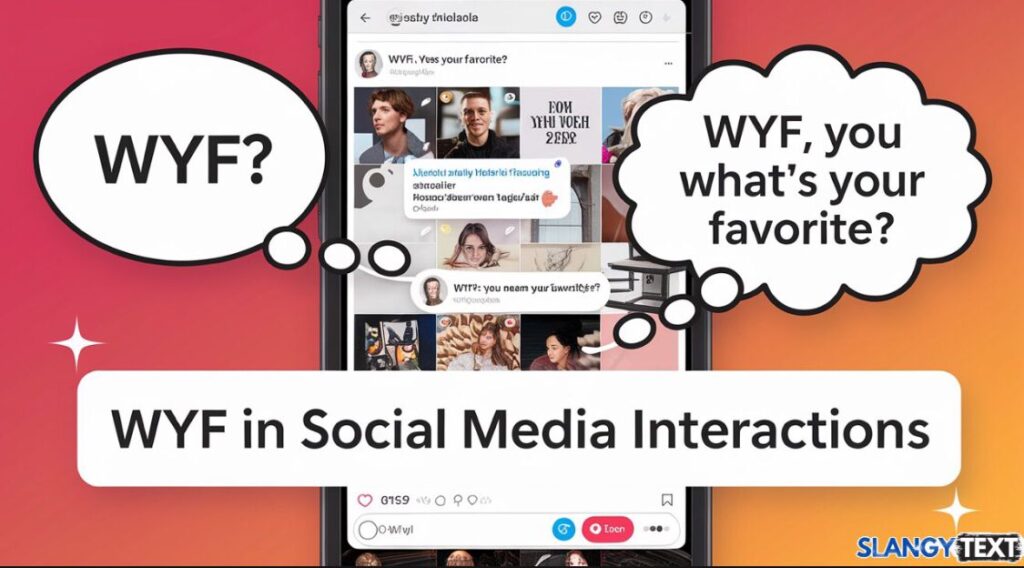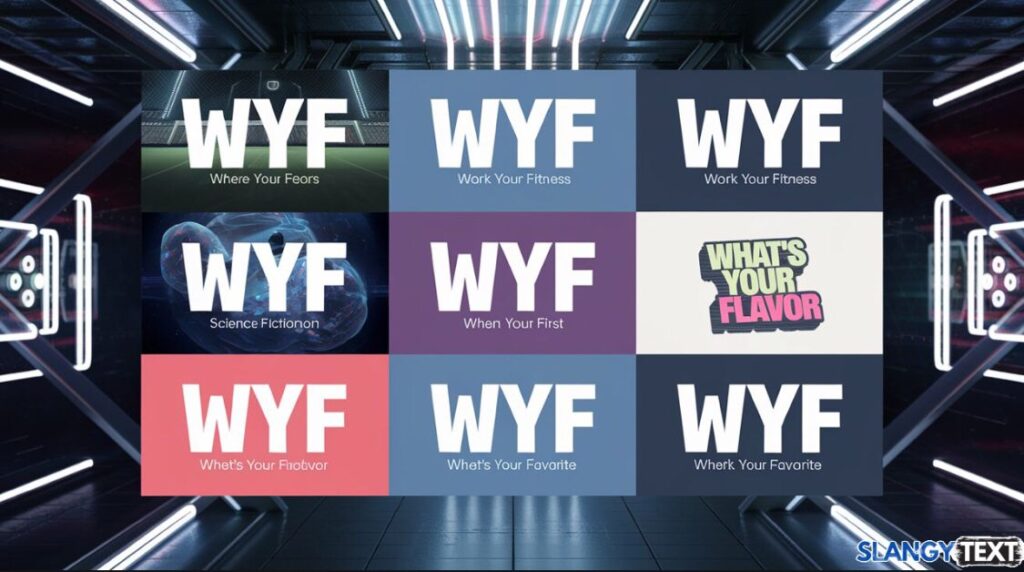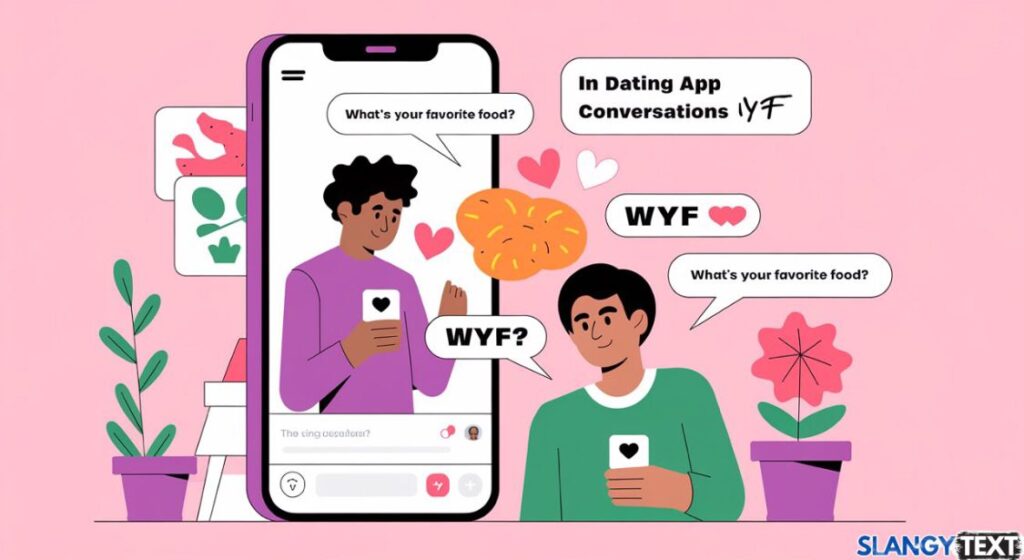In the vast landscape of digital communication, abbreviations and acronyms reign supreme. One such shorthand that’s gained traction is WYF. But what does WYF mean in texting?
Let’s dive into the world of online lingo and uncover the meaning behind these three simple letters.
Basic Meaning
At its core, WYF stands for “Where You From?” It’s a casual way to ask about someone’s origin, hometown, or current location. This abbreviation has become a staple in online conversations, especially when meeting new people in digital spaces.
WYF in Action: Real-World Scenarios
To better understand how WYF is used, let’s look at some typical scenarios where you might encounter this abbreviation.
Social Media Interactions
Imagine scrolling through Instagram and coming across a comment like this:
“Your photos are amazing! WYF? I’d love to visit those places!”
Here, the commenter is expressing admiration and curiosity about the photographer’s location. It’s a way to start a conversation and potentially connect over shared interests in travel or photography.

Online Gaming Communities
In multiplayer games, players often use WYF to learn about their teammates’ locations. For example:
Player1: “Great game! WYF? Your ping is so low!” Player2: “Thanks! I’m from Chicago. You?”
This exchange not only satisfies curiosity but can also lead to discussions about server locations and connection speeds.

Dating Apps
On platforms like Tinder or Bumble, WYF is frequently used as an ice-breaker:
Match1: “Hey there! Your profile caught my eye. WYF?” Match2: “Hi! I’m from Seattle. How about you?”
This simple question can open the door to conversations about local attractions, shared experiences, or even potential meet-ups if the matches are nearby.
Evolution

The origin of WYF can be traced back to the late 1990s, coinciding with the rise of online chat rooms and instant messaging. As internet users sought ways to communicate more efficiently, abbreviations like WYF emerged as time-savers.
Over time, WYF has evolved beyond its initial meaning. Let’s explore some variations:
| Context | Meaning | Example Usage |
|---|---|---|
| General Inquiry | Where You From | “Nice to meet you! WYF?” |
| Travel Discussion | Where You Flying | “WYF next month? I heard you’re going on vacation.” |
| Music Scenes | What’s Your Flavor | “WYF in hip-hop? Old school or new wave?” |
| Fashion Trends | What’s Your Fit | “WYF today? I’m going for a casual look.” |
| Food Preferences | What’s Your Favorite | “WYF when it comes to pizza toppings?” |
| Relationship Status | Who’s Your Flame | “So, WYF these days? Anyone special?” |
| Career Aspirations | Where You Focused | “WYF in your career right now? Any big goals?” |
| Hobby Inquiry | What’s Your Forte | “You seem talented. WYF in the creative arts?” |
| Emotional Check-in | Where You Feel | “Hey, just checking in. WYF emotionally today?” |
| Spiritual Beliefs | What’s Your Faith | “I’m curious about your beliefs. WYF spiritually?” |
You might also like to read this: What Does “El Belicon” Mean?
WYF and Cultural Sensitivity
While WYF is generally considered a friendly inquiry, it’s important to remember that questions about origin can be sensitive for some individuals. Always be mindful of the context and your relationship with the person you’re addressing.
The Art of Using WYF: Best Practices
Now that we understand what WYF means, let’s discuss how to use it effectively and appropriately in digital conversations.
Timing is Everything
Dropping a WYF too early in a conversation might come across as abrupt. It’s often better to establish a rapport first before diving into personal questions about someone’s location or background.
Consider the Platform
The appropriateness of using WYF can vary depending on the platform. For instance:
Professional Networking Sites
On LinkedIn, it’s generally better to avoid abbreviations like WYF. Instead, opt for more formal language:
“I noticed from your profile that you have experience in the New York market. May I ask which area you’re currently based in?”
Casual Social Media
On platforms like Twitter or Instagram, WYF is more acceptable:
“Love your street photography! WYF? The architecture in your shots is stunning!”
Follow-Up Questions
Once you’ve asked WYF and received a response, show genuine interest by asking follow-up questions. This demonstrates that you’re not just making small talk but are genuinely interested in learning more about the person.
Also like to know this : What Does Guerito Mean in Texting (TikTok & Social Media)
WYF and Emojis: Adding Flavor to Digital Conversations
In the colorful world of texting, emojis often accompany abbreviations like WYF to add context or emotion. Here’s how different emojis can change the tone of WYF:
| Emoji Combination | Implied Tone | Example Usage |
|---|---|---|
| WYF 🌎 | General curiosity | “WYF 🌎? I love learning about different places!” |
| WYF 🏙️ | Urban inquiry | “Those skyline pics are amazing! WYF 🏙️?” |
| WYF 🏝️ | Vacation vibes | “Your beach photos are giving me life! WYF 🏝️?” |
| WYF 🤔 | Thoughtful curiosity | “Interesting perspective. WYF 🤔? I’d love to know more about your background.” |
| WYF 😍 | Admiration | “Your accent is beautiful! WYF 😍?” |
| WYF 🎓 | Academic interest | “That research sounds fascinating. WYF 🎓? I’m curious about different educational systems.” |
| WYF 🍽️ | Culinary curiosity | “That dish looks delicious! WYF 🍽️? I want to try the local cuisine!” |
| WYF 🎭 | Cultural inquiry | “Your traditional dress is stunning! WYF 🎭? I’d love to learn more about your culture.” |
| WYF 🏛️ | Historical interest | “The architecture in your photos is breathtaking. WYF 🏛️? I’m a history buff!” |
| WYF 🌿 | Rural curiosity | “Those rolling hills look so peaceful. WYF 🌿? I’ve always wanted to visit the countryside.” |
WYF Alternatives: Expanding Your Digital Vocabulary
While WYF is a popular choice, there are several other ways to ask about someone’s location or background in digital conversations. Here are some alternatives to keep your chats fresh and engaging:
| Abbreviation | Full Phrase | Example Usage |
|---|---|---|
| WAYF | Where Are You From | “WAYF? Your accent sounds interesting!” |
| WYAL | Where You At, Literally | “WYAL? Maybe we’re in the same city!” |
| WYBN | Where You Been, Nerd | “WYBN? Haven’t seen you online in ages!” |
| WYSH | Where’s Your Second Home | “WYSH? I heard you travel a lot for work.” |
| WYHF | Where You Hang, Fam | “WYHF these days? Still in the old neighborhood?” |
| WYCS | What’s Your Current Situation | “WYCS? Still working remotely or back in the office?” |
| WYGL | Where You Gonna Land | “WYGL after graduation? Any cities in mind?” |
| WYGR | Where You Gonna Retire | “WYGR? I hear Florida’s nice this time of year!” |
| WYHU | Where You Heading, Uh | “WYHU for the holidays? Any exciting plans?” |
| WYSA | Where’s Your Safe Space | “WYSA when you need to unwind? Beach, mountains, or city?” |
You might also like : What Does WSG Mean In Texting?
The Impact of WYF on Digital Communication
The widespread use of abbreviations like WYF has significantly influenced how we communicate online. Let’s explore some of the effects:
Efficiency in Conversation
WYF and similar shorthand allow users to convey questions quickly, especially on platforms with character limits like Twitter. This efficiency can lead to more dynamic and fast-paced conversations.
Breaking Language Barriers
Abbreviations like WYF can sometimes transcend language barriers. Non-native English speakers might find it easier to understand and use these short forms in international online communities.
Creating In-Group Language
The use of WYF and other internet slang can create a sense of community among users. Understanding and using these terms can make individuals feel part of an in-group, particularly in specific online subcultures.
WYF in Different Age Groups: A Generational Perspective
The use and understanding of WYF can vary across different age groups. Here’s a breakdown of how various generations typically interact with this abbreviation:
| Age Group | Typical Usage | Example Scenario |
|---|---|---|
| Gen Z (Born 1997-2012) | Frequent, casual use | Sarah (18): “WYF? Your TikToks are fire 🔥” |
| Millennials (Born 1981-1996) | Common use, especially in informal settings | Mike (32): “WYF originally? I’m thinking of relocating for work.” |
| Gen X (Born 1965-1980) | Occasional use, often learned from younger colleagues or children | Linda (50): “My daughter taught me this. WYF? Did I use it correctly? 😊” |
| Baby Boomers (Born 1946-1964) | Rare use, might misinterpret | Bob (65): “WYF? Is that some kind of new social media platform?” |
| Silent Generation (Born 1925-1945) | Very rare use, often unfamiliar | Margaret (80): “In my day, we wrote complete sentences. What does WYF mean?” |
| Alpha Generation (Born 2013-present) | Growing up with these abbreviations as norm | Zoe (10): “Mom, can I use WYF in my school project about internet communication?” |
| Digital Natives (Born into internet era) | Intuitive understanding and use | Alex (22): “WYF? Let’s meet up if you’re in the area!” |
| Digital Immigrants (Adopted internet later in life) | Learned use, sometimes awkward | Tom (55): “WYF… Did I do that right? I’m trying to keep up with the times!” |
| Multilingual Users | Use in combination with other languages | Maria (28): “Hola! WYF? I’m practicing my Spanglish 😉” |
| Global Nomads | Frequent use due to mobile lifestyle | Jake (40): “WYF this month? I’ve lost track of your travels!” |
You might also like : What Dos OMM Mean?
The Psychology Behind Asking “Where You From”
The question “Where are you from?” – whether asked in full or abbreviated as WYF – taps into fundamental aspects of human psychology and social interaction.

Identity and Belonging
Asking WYF often goes beyond mere curiosity about geographical location. It’s a way of understanding someone’s cultural background, experiences, and potential shared connections. This question can help people find common ground and establish a sense of belonging.
Cognitive Mapping
When we learn where someone is from, our brains often make quick associations based on our knowledge or stereotypes about that place. This cognitive mapping helps us to categorize and understand new acquaintances more quickly.
Conversation Starter
WYF serves as an easy, non-threatening way to initiate conversation. It’s open-ended enough to allow the respondent to share as much or as little as they’re comfortable with.
in Popular Culture
The concept of asking “Where you from?” has been featured in various forms of media, often reflecting its significance in social interactions.
Music References
Many songs across different genres have incorporated the phrase “Where you from?” in their lyrics. For example, the hip-hop culture often uses this question to establish street credibility or regional identity.
Movie and TV Show Dialogues
In films and television series, the question “Where you from?” is frequently used to establish character backgrounds or create tension between characters from different places.
Social Media Challenges
Some social media platforms have seen “Where You From” challenges, where users share unique aspects of their hometowns or current locations.
The Future of WYF: Evolving Language in a Digital World
As digital communication continues to evolve, so too will abbreviations like WYF. Here are some potential trends we might see:
Voice-to-Text Impact
With the increasing use of voice-to-text technology, we might see a decrease in abbreviations like WYF in favor of full phrases. However, the convenience of short forms may lead to their persistence even in voice messages.
Augmented Reality Integration
As AR technology develops, asking WYF might trigger location-based information overlays, providing instant visual context about the respondent’s location.
AI-Powered Contextual Understanding
Future AI assistants might be able to interpret WYF based on the full context of a conversation, providing more nuanced translations or suggestions for response.
Conclusion
In the grand tapestry of internet language, WYF holds a special place. It’s more than just a shorthand for “Where you from?” – it’s a reflection of our increasingly connected world, where curiosity about others’ backgrounds and locations is just a few keystrokes away.
Whether you’re a seasoned digital native or new to the world of online abbreviations, understanding and using WYF can enhance your digital communication skills. Remember to use it thoughtfully, considering the context and your audience.
As we continue to navigate the ever-changing landscape of digital interaction, abbreviations like WYF serve as reminders of how language adapts to new mediums. They challenge us to balance efficiency with clarity, and brevity with meaningful connection.
So, the next time you see WYF pop up in a chat or comment section, you’ll not only know what it means, but you’ll also appreciate the complex web of social, psychological, and technological factors that have made these three letters a significant part of our digital lexicon.
You might like : What Does WYF Mean In Texting?

Kayla Rogers is a writer at Slangy Text who loves exploring modern acronyms & slangs and how they shapes our conversations. She enjoys sharing fun and interesting articles that connect with readers. When she’s not writing, Kayla likes to keep up with the latest trends or relax with a good book.







